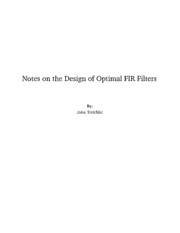Table Of ContentNotes on the Design of Optimal FIR Filters
By:
John Treichler
Notes on the Design of Optimal FIR Filters
By:
John Treichler
Online:
< http://cnx.org/content/col10553/1.3/ >
C O N N E X I O N S
RiceUniversity,Houston,Texas
This selection and arrangement of content as a collection is copyrighted by John Treichler. It is licensed under the
Creative Commons Attribution 2.0 license (http://creativecommons.org/licenses/by/2.0/).
Collection structure revised: September 14, 2009
PDF generated: February 3, 2011
For copyright and attribution information for the modules contained in this collection, see p. 39.
Table of Contents
1 Introduction to "Notes on the Design of Optimal FIR Filters" ..............................1
2 Statement of the Optimal Linear Phase FIR Filter Design Problem ..... ...................3
3 Filter Sizing ........................................................................................7
4 Performance Comparsion with other FIR Design Methods ..................................13
5 Three Methods of Designing FIR Filters ......................................................19
6 Why Does α Depend on the Cuto(cid:27) Frequency? ..............................................23
7 Extension to Non-lowpass Filters ...............................................................25
8 Bibliography for "Notes on the Design of Optimal FIR Filters" ............................27
9 "Notes on the Design of Optimal FIR Filters" Appendix A .................................29
10 "Notes on the Design of Optimal FIR Filters" Appendix B ................................31
11 "Notes on the Design of Optimal FIR Filters" Appendix C ................................35
Bibliography ........................................................................................37
Index ................................................................................................38
Attributions .........................................................................................39
iv
Chapter 1
Introduction to "Notes on the Design of
Optimal FIR Filters"1
Introduction
Arecurringtechnicaltaskinthedevelopmentofdigitalsignalprocessingproductsandsystemsisthedesign
of (cid:28)nite-impulse-response (FIR) digital (cid:28)lters. Fortunately some excellent software packages exist for the
automatic synthesis of impulse responses for such (cid:28)lters, many of them based on the now-famous Parks-
McClellan algorithm [2]. Unfortunately, there is still some mystery about how to use the software and,
equallyimportant,howtoestimateimpulseresponselengthsshortofactuallydesigningthe(cid:28)lteritself. This
technical note primarily addresses the second problem and indirectly discusses a bit the (cid:28)rst. We examine
here how to convert a typical (cid:28)lter speci(cid:28)cation in terms of cuto(cid:27) frequency, passband ripple, etc., into a
reasonably accurate estimate of the length of the impulse response. Not only does this estimate su(cid:30)ce for
most design tradeo(cid:27) exercises, it usually allows the Parks-McClellan routines to be employed only once or
twice rather than the multiple times needed when the (cid:16)cut-and-try" method is used.
1Thiscontentisavailableonlineat<http://cnx.org/content/m17231/1.3/>.
1
CHAPTER 1. INTRODUCTION TO "NOTES ON THE DESIGN OF
2
OPTIMAL FIR FILTERS"
Chapter 2
Statement of the Optimal Linear Phase
FIR Filter Design Problem1
2.1 Equal-ripple Design
While other types of (cid:28)lters are often of interest, this note focuses on the lowpass linear phase (cid:28)lter. Even
though it is not immediately obvious, virtually all of the analytical results developed in this note apply to
the other types as well. This fact is ampli(cid:28)ed in the module Extension to Non-lowpass Filters (Chapter 7).
It is known that the Parks-McClellan (cid:28)lter synthesis software package produces (cid:16)optimal" (cid:28)lters in the
sense that the best possible (cid:28)lter performance is attained for the number of (cid:16)(cid:28)lter taps" allowed by the
designer. (cid:16)Optimal" can be de(cid:28)ned various ways. The Parks-McClellan package uses the Remez exchange
algorithm to optimize the (cid:28)lter design by selecting the impulse response of given length, termed here N,
which minimizes the peak ripple in the passband and stopband. It can be shown, though not here, that
minimizingthepeak, ormaximum, rippleisequivalenttomakingallofthelocalpeaksintherippleequalto
eachother. Thisfactleadstothreedi(cid:27)erentnamesforessentiallythesame(cid:28)lterdesign. Theyarecommonly
called (cid:16)equal-ripple" (cid:28)lters, because the local peaks are equal in deviation from the desired (cid:28)lter response.
Because the maximum ripple deviation is minimized in this optimization procedure, they are also termed
2
(cid:16)minimax" (cid:28)lters. Finally, since the Russian Chebyshev is usually associated with minimax designs , these
(cid:28)lters are often given his name.
The design template for an equal-ripple lowpass (cid:28)lter is shown in Figure 2.1.
1Thiscontentisavailableonlineat<http://cnx.org/content/m17232/1.4/>.
2He developed the concept of minimax design and a set of polynomials which carry his name not from (cid:28)lter design, but
fromtheoptimaldesignofpistondriverodsforsteamlocomotives. Theyarediscussedmorein"FilterSizing"(Chapter3)and
AppendixB(Chapter10).
3
CHAPTER 2. STATEMENT OF THE OPTIMAL LINEAR PHASE FIR
4
FILTER DESIGN PROBLEM
Figure 2.1: Frequency Response of an Optimal Weighted Equal-ripple Linear Phase FIR Filter
Thepassbandextendsfrom0Hztothecuto(cid:27)frequencydenotedf . Thegaininthepassbandisassumed
c
to be unity. Any other gain is attained by scaling the whole impulse response appropriately. The stopband
begins at the frequency denoted f and ends at the so-called Nyquist or (cid:16)folding" frequency, denoted by
st
fs, where f is the sampling frequency of the data entering the digital (cid:28)lter. In some references, [1] for
2 s
example, the sampling rate f is assumed to be normalized to unity just as the passband gain has here. The
s
dependence on the sampling frequency is kept explicit in this note, however, so that its impact on design
parameters can be kept visible.
The optimal synthesis algorithm is assumed here to produce an impulse response whose associated fre-
quency response has ripples in both the passband and the stopband. The peak deviation in the passband is
denoted δ and the peak deviation in the stopband is denoted δ . It is commonly thought that an (cid:16)equal-
1 2
ripple" design forces δ to equal δ . In fact this is not true. The local ripple peaks in the passband will
1 2
all equal δ and those in the stopband will all equal δ . For a given (cid:28)lter speci(cid:28)cation the two are linked
1 2
together by a weight denoted W, so that δ =Wδ . In fact the Parks-McClellan routines insure the design
1 2
of weighted equal-ripple (cid:28)lters. The choice of W is discussed shortly.
An important design parameter is the transition band, denoted ∆f, and de(cid:28)ned as the di(cid:27)erence
between the stopband edge f and the passband edge f . Thus,
st c
∆f =f − f . (2.1)
st c

